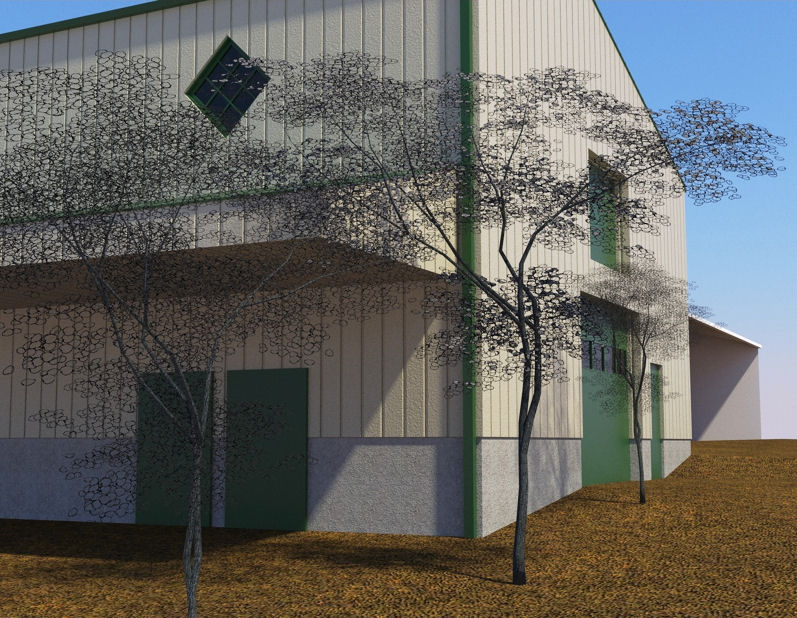Could'ya/would'ya use trees like these?
-
Woke up this morning with this crazy idea and decided to trash out a quick concept model. (The render just proved the leaf edge line would actually cast a shadow :`)
Anyway, if you could/would use them:
Which do you prefer?
Where/how would you use them?
What would make them better?
Would a transparent line-drawing bark texture be useful?


-
Hi, tomsdesk:
I noticed that there weren't many responses so far. I think based on the images that these trees would make excellent accessories to a scene in which the building is more important than the stuff around it. Nice work. -
I agree. I would like it better if the leaves had some green color to them though. Something very transparent, but hinted at green. That might be a nice touch.
-
They would also look really great as colored blossoms, as some trees bloom this way before leafing out. Nice work!
-
Good idea Tom and one that might appeal to many building designers as they often just want to suggest a tree rather than have the tree obscure the structure.
Yes, I also agree that a hint of green for Summer / Spring and would also suggest brown for Autumn might be a further option. The ones you show would work well for Winter scenes.
On the number of comments! I see there are 20 downloads and the only the usual forum members offer the feedback sought! Its a great pity that we would appear to have so many ill mannered members in SketchUcation

-
Tom,
I disagree about adding color, I like the traced look leaves, however I may suggest having hollow/trcaed trunks also as they seem to dominate the effect.
-
Thanks for these Tom. I think they would be very usefull where landscaping is required but where you need it "implied" rather than stated strongly. The slight color tint may also be usefull.
-
Wow! Thanks guys...I had all but given up on the project ('cause I couldn't really think where I'd use them either :`) You can already change the color of the leaves (the bark too) in the SU material editor and I will play around with a transparent bark texture.
Best, Tom. -
I like these. I'm collecting trees to use to try out effects. These have a nice appearance, and although thin, they feel far more real than many of the trees I've seen, at least as rendered in the image in your post.
(2 minute pause...)
I just downloaded them. They aren't as convincing just in SU, but then I expect orbits would take forever.
Real trees have more variation. E.g. NO two trees will have the same branch pattern. Modeling this is hard. You need to pick a species of tree, and take dozens of pictures.
I'm still learning SU (I'm a newbie) It would be way cool if these were truly dynamic components. E.g. if I scale the tree, it doesn't just draw the whole thing bigger, but rather, the branches get heavier, and new material is added at the outside. This would also help with the unique aspect.
Several people have commented on color. I'll go a step further: Suppose you provided them as models, but created them in 5 layers. Layer 0 Trunk-Branch-twig. Layer 1 Blossoms Layer two Summer foliage. Layer 3. Fall Folliage. Layer 4 Fruit/seeds.
Certain things tend to be invariant on a given species of tree:
One is twig angle. Some trees have twigs at right angles to the branch. Many have angles of roughly 60 degrees. Most columnar trees (Tower poplar, Swedish aspen, columnar spruce the ONLY genetic difference is the gene that controls this angle.Another is twig spacing, although this tends to vary with light levels. Many plants distribute the radial angle of the side branch on a fibonacci series. (Corn is a good example, where it's really easy to see.) Others will do whorls of branches. Most conifers do this, and it's really obvious when they are young, and is really hard to see when they get older.
The ratio of daughter branches to parent is also a common constant, as is the ratio of branch diameter to the distance to the next branch point. You've captured this very well in your trees, and I think to me that is a big part of the appeal.
Another is light response. Many shrub willows will send out branches at an angle of about 20 degrees above the horizontal, then as they get out from under the rest of the tree curve up.
A third is raggedness. Some trees when you look at them in winter almost look as if someone pruned them to make a nice smooth outline. Others look like a botched haircut.
Not all characteristics are invariant within a species. One variety of blue spruce has very even length needles. Another has a 30% variation in length on the same twig. Some spruce have very evenly space branches as they get older. Others have branches that droop at various angles.
Many trees have different trunk bark than twig bark. 1 year bark on most poplar is a grey-green. Older bark is pale grey. Trunk bark is dark grey with fissures. Birch twigs are the colour of hershey's chocolate until they are finger thick. Then the white spots spread out and turn the branch paper white with dark markings. Golden willow has yellowish grey branches except for this year's new growth. THAT in winter is schoolbus yellow with orange tips.
Advertisement







